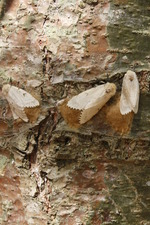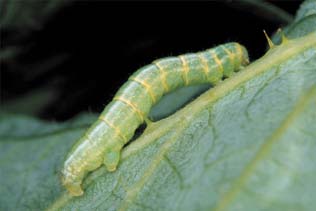Male winter moth
Young caterpillar
The Winter moth is a pest often seen in areas of the North Shore. They will feed on many deciduous hosts, but seem to prefer fruit trees (productive and ornamental) maple, ash and oak. Multitudes of flying males emerge from the ground around Thanksgiving, looking to mate with the flightless females. The females lay their egg casings in cracks and crevices in the tree trunk. Tiny caterpillars emerge just as deciduous buds swell, and worm their way into the bud.
The feeding begins immediately and can cause serious leaf and flower damage before they get a chance to open. The caterpillars will continue to feed until early June, when they will drop to the ground and pupate in the soil. The moths will emerge in the late fall, and the cycle begins again. Treatment is available, but timing is crucial.
The Gypsy moth is making a strong return. This disturbingly unpleasant pest has no serious predatory threats and can defoliate a large tree in a weeks time. Gypsy moth larvae prefer hardwoods, but may feed on several hundred different species of trees and shrubs. In the notheast, the gypsy moth prefers oaks, apple, speckled alder, basswood, gray and white birch, poplar, willow, and hawthorn, although other species are also affected, especially during heavy infestations.
Damage on Oak
A completely defoliated White pine
Older larvae feed on several species of hardwood that younger larvae avoid, along with hemlock, pines and native spruces. During periods when gypsy moth populations are dense, larvae feed on almost all vegetation. Gypsy moth egg masses are laid on branches and trunks of trees but egg masses may be found in any sheltered location. The hatching of gypsy moth eggs coincides with budding of most hardwood trees. Larvae emerge from egg masses from early spring through mid-May. When population numbers are dense, larvae feed continuously day and night until the foliage of the host tree is stripped. Then they crawl in search of new sources of food.

From mid-June and early July. The larva enter the pupal stage, during which larvae change into moths. Pupation lasts from 7 to 14 days. Pupation takes place under flaps of bark, in crevices, under branches, on the ground, and in other places where larvae rested. When population numbers are dense, pupation will take place in sheltered and non-sheltered locations, even exposed on the trunks of trees or on foliage of nonhost trees.
The male gypsy moth emerges first, flying in serpentine patterns searching for females. When heavy, egg-laden females emerge, they emit a pheromone that attracts the males The female lays her eggs in July and August, then both adult gypsy moths die.
Four to six weeks later, embryos develop into larvae. The larvae remain in the eggs during the winter. The eggs hatch the following spring.






